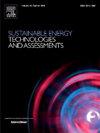Parametric design for combined solar facades for high-rise residential buildings
IF 7.1
2区 工程技术
Q1 ENERGY & FUELS
Sustainable Energy Technologies and Assessments
Pub Date : 2025-02-01
DOI:10.1016/j.seta.2024.104167
引用次数: 0
Abstract
The integration of solar photovoltaic (PV) modules with building facades offers a sustainable solution for generating clean energy and enhancing architectural design. Both PV facades and PV shadings are Building Integrated Photovoltaic (BIPV) products that can be utilized to achieve net-zero buildings. In addition to energy performance metrics, aesthetics are equally crucial considerations in integrative photovoltaic design. Expeditiously approximating and optimizing projected energy yields attendant to integrative photovoltaic implementation during formative design phases would meaningfully support the evolutionary process. This study explores a combined solar facades system, consisting of colored opaque facade-integrated photovoltaics (FIPV) attached to the building’s walls and passive solar shadings. This research first employs regression methods to model the shading impact on solar radiation and then uses a parametric approach to evaluate and optimize the combined solar facades system on the facade of a high-rise residential building in Hong Kong. Furthermore, the effects of geometric and color parameters of solar shadings and solar walls on the energy efficiency and total power harvesting were analyzed. In conclusion, a combined solar facades system shows promise for net-zero energy buildings. Opportunities to refine integrated CAD 3D modeling and simulation tools were noted to further optimize design decisions for BIPV projects in the early design stage.
求助全文
约1分钟内获得全文
求助全文
来源期刊

Sustainable Energy Technologies and Assessments
Energy-Renewable Energy, Sustainability and the Environment
CiteScore
12.70
自引率
12.50%
发文量
1091
期刊介绍:
Encouraging a transition to a sustainable energy future is imperative for our world. Technologies that enable this shift in various sectors like transportation, heating, and power systems are of utmost importance. Sustainable Energy Technologies and Assessments welcomes papers focusing on a range of aspects and levels of technological advancements in energy generation and utilization. The aim is to reduce the negative environmental impact associated with energy production and consumption, spanning from laboratory experiments to real-world applications in the commercial sector.
 求助内容:
求助内容: 应助结果提醒方式:
应助结果提醒方式:


